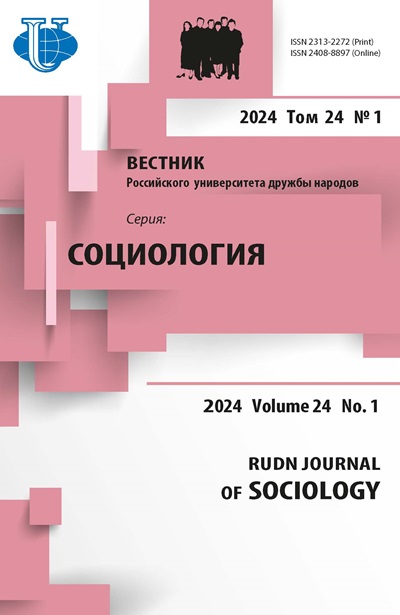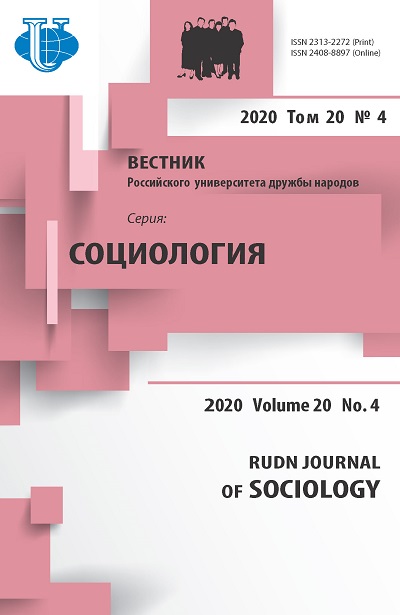Cognitive form of social norms: a survey experiment
- Authors: Babich N.S.1,2
-
Affiliations:
- Institute of Sociology of the FCTAS RAS
- RUDN University
- Issue: Vol 20, No 4 (2020)
- Pages: 790-800
- Section: Theory, Methodology and History of Sociological Research
- URL: https://journals.rudn.ru/sociology/article/view/25211
- DOI: https://doi.org/10.22363/2313-2272-2020-20-4-790-800
Cite item
Full Text
Abstract
In the minds of members of society, social norms can exist in various forms. In their most general form, they are logical rules ‘if, then’. The theoretical framework most often used to study social norms is the “focus theory of normative conduct” which divides this logical rule into two types of norms - descriptive (‘the majority does this’) and injunctive (‘I should do this’). It is not known which of these three possible forms prevails (is most common or fundamental) in the minds of members of society, and this question should be answered empirically, for instance, by measuring the time of reaction to different descriptions of a social norm. If the description corresponds to the cognitive form of the norm, the reaction should be faster, since it takes less time and resources to compare and interpret wordings. The article presents the results of an experimental study of the cognitive accessibility of social norms in mass survey based on the method of ‘split-ballot’ which implies the presentation of different versions of the questionnaire to randomly selected subsamples. The survey consisted of 10 questions about attitudes to social norms in a particular situation: half of situations described a common norm, half - a violation of the norm. Each situation was described in three ways: implication (‘if, then’), common behavior, and imperative. The main measured variable was not the answers but the time for providing them. The results showed no statistically significant differences in timing of reactions to different forms of situation descriptions. Thus, the main result of the study is that three possible cognitive forms of social norms turn out to be equal, with no signs of prevalence or greater fundamentality. This can be explained in two ways: first, each cognitive form can use its own independent mechanism of actualization; second, the true cognitive form can differ from all three (for example, a non-verbal representation of actions). The choice between these two explanations requires further research.
About the authors
N. S. Babich
Institute of Sociology of the FCTAS RAS; RUDN University
Author for correspondence.
Email: sociolog@mail.ru
кандидат социологических наук, старший научный сотрудник Института социологии Федерального научно-исследовательского социологического центра Российского академии наук; доцент кафедры социологии Российского университета дружбы народов
Krzhizhanovskogo St., 24/35-5, Moscow, 117218, Russia; Miklukho-Maklaya St., 6, Moscow, 117198, RussiaReferences
- Boudon R. Sotsialnye mekhanizmy bez “chernykh yashchikov” [Social mechanisms without “black boxes”]. Sotsiologiya na poroge XXI veka. Ed. by S.I. Grigoryev. Мoscow; 1998 (In Russ.).
- Alvarez-Benjumea A., Winter F. Normative change and culture of hate: An experiment in online environments. European Sociological Review. 2018; 3.
- Burger J.M., Shelton M. Changing everyday health behaviors through descriptive norm manipulations. Social Influence. 2011; 2.
- Buunk B.P., Bakker A.B. Extradyadic sex: The role of descriptive and injunctive norms. Journal of Sex Research. 1995; 4.
- Chung A., Rimal R.N. Social norms: A review. Review of Communication Research. 2016; 4.
- Cialdini R.B., Reno R.R., Kallgren C.A. A focus theory of normative conduct: Recycling the concept of norms to reduce littering in public places. Journal of Personality and Social Psychology. 1990; 6.
- Cialdini R.B. The focus theory of normative conduct. Handbook of Theories of Social Psychology. Vol. 2. Ed. by P.A.M. van Lange, A.W. Kruglanski, E.T. Higgins. London; 2012.
- Elsenbroich C., Gilbert N. Modelling Norms. Dordrecht; 2014.
- Horne C. Sociological perspectives on the emergence of social norms. Social Norms. Ed. by M. Hechter, K.-D. Opp. New York; 2001.
- Huber P.J. Robust Statistical Procedures. Philadelphia; 1996.
- Interis M. On norms: A typology with discussion. American Journal of Economics and Sociology. 2011; 2.
- Jacobson R.P., Mortensen C.R., Cialdini R.B. Bodies obliged and unbound: Differentiated response tendencies for injunctive and descriptive social norms. Journal of Personality and Social Psychology. 2011; 3.
- Jones T. “We always have a beer after the meeting”: How norms, customs, conventions, and the like explain behavior. Philosophy of Social Sciences. 2006; 3.
- Martin J.G. Ideal and typical social norms. Sociological Inquiry. 1964; 1.
- Meisel M.K., Goodie A.S. Descriptive and injunctive social norms’ interactive role in gambling behavior. Psychology of Addictive Behaviors. 2014; 2.
- Melnyk V., van Herpen E., Fischer A.R.H., van Trijp H.C.M. Regulatory fit effects for injunctive versus descriptive social norms: Evidence from the promotion of sustainable products. Marketing Letters. 2013; 2.
- Pollis N.P., Pollis C.A. Sociological referents of social norms. Sociological Quarterly. 1970; 2.
- Schultz W.P., Khazian A.M., Zaleski A.C. Using normative social influence to promote conservation among hotel guests. Social Influence. 2008; 1.
- Sumner W.G. Folkways. Boston; 1907.














